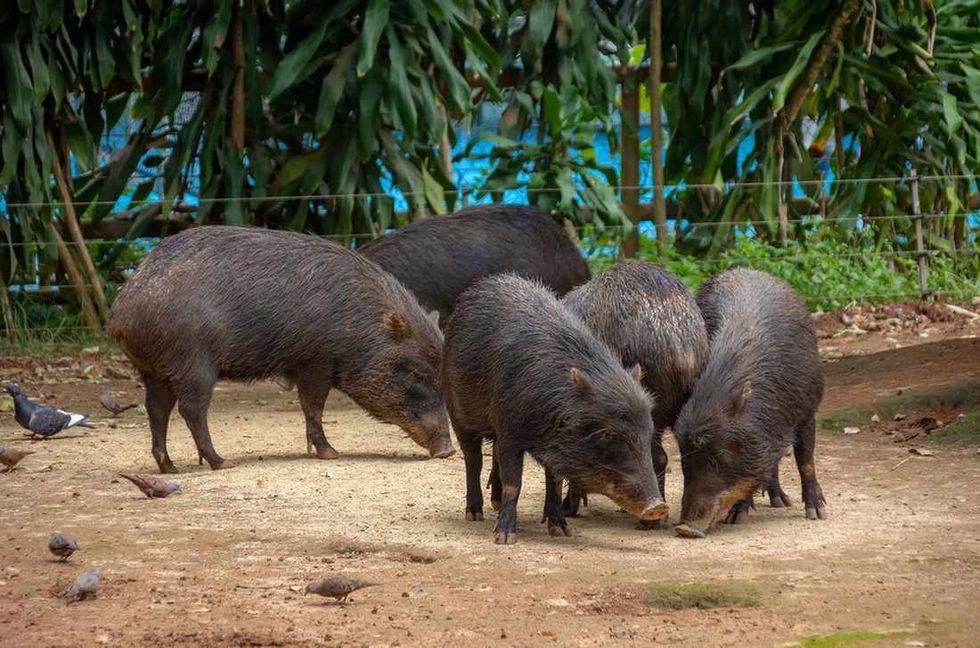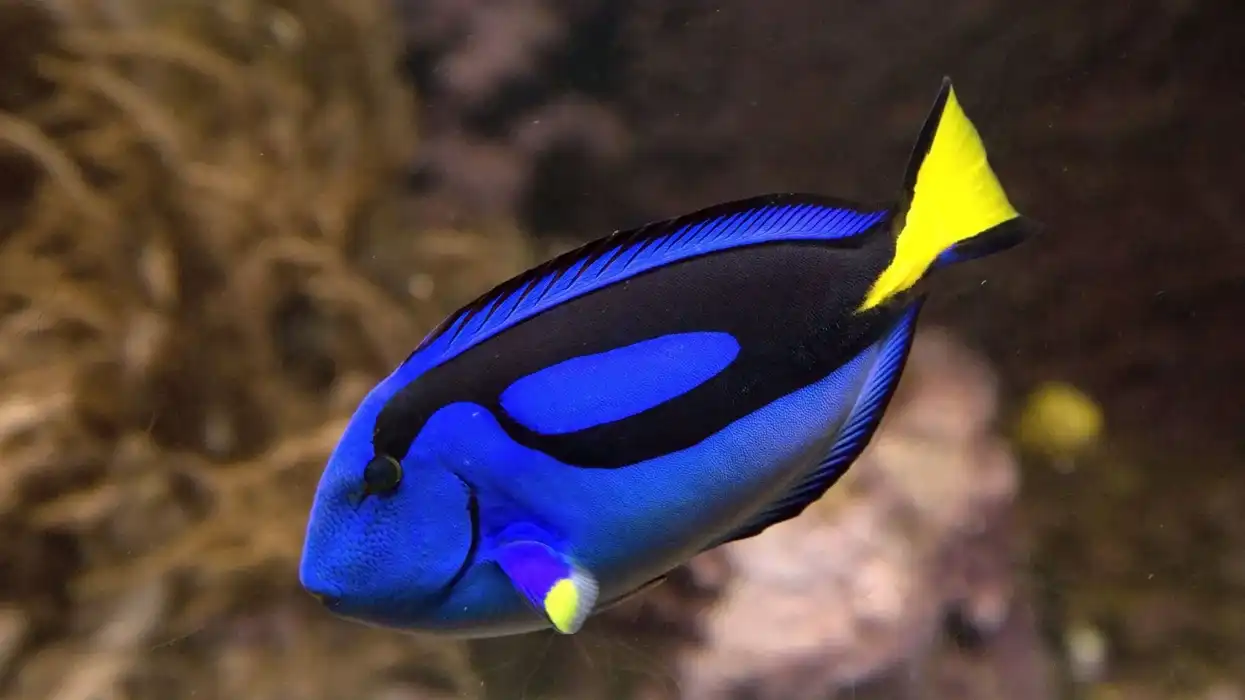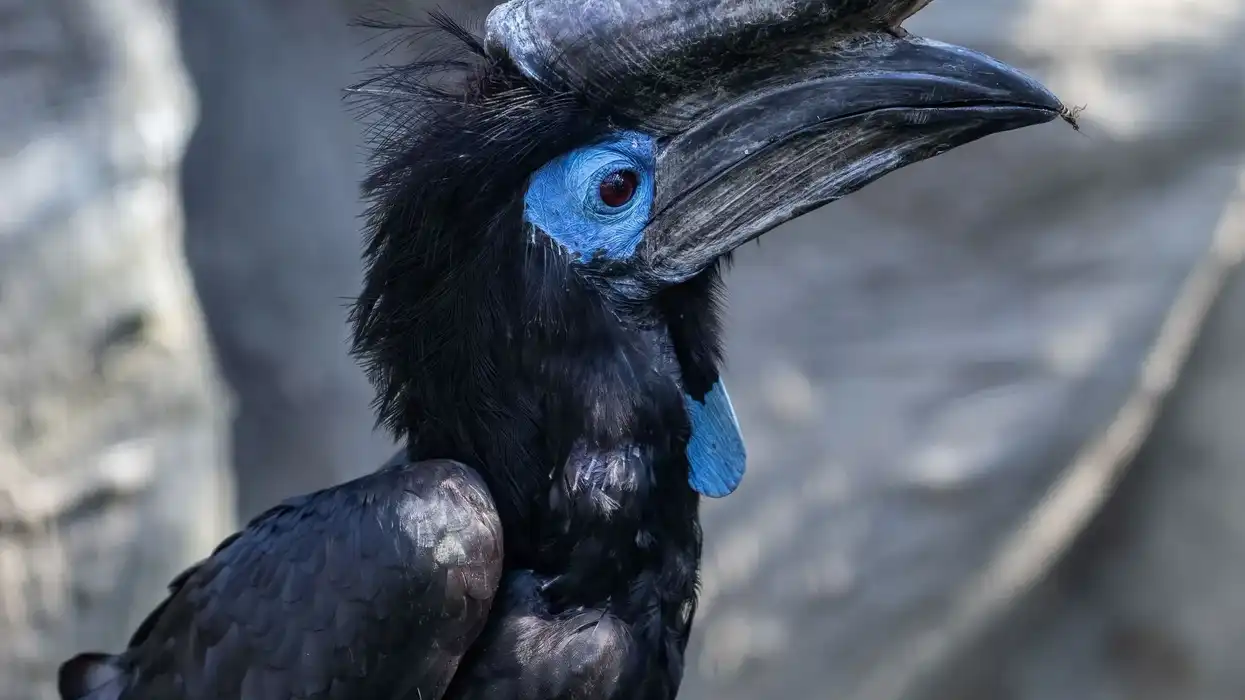While lipped peccaries (Tayassu pecari), or javelina, are medium-sized mammals found in Central and South America, and in certain parts of North America. These animals greatly resemble pigs and wild boars but are not related.
It is covered in dark brown fur and has a stocky appearance. It has a white lining across its pelvic area and on its neck, hence its name. The young peccary has a mix of red, brown, black, and cream-colored skin.
Often found in large herds, these hooved mammals have an interesting way to mark and identify each other. Each animal has a scent gland that guides this behavior. Being nomads, they can be found roaming around in search of food and water.
They are active both during days and nights and keep traveling within their home range. White-lipped peccary has a home range of home range 23–77 sq mi (60 and 200 sq.
km). The number of individuals in these herds provides unity against their predators. White-lipped peccaries prefer habitats such as rainforests, grasslands, and deserts.
Read on to know more about white-lipped peccaries' preferred habitats, breeding behavior, and other tendencies. If you had fun learning about this mammal, consider reading about the pitbull Chihuahua mix and the pocket pitbull.
White-Lipped Peccary Interesting Facts
What type of animal is a white-lipped peccary?
White-lipped peccaries (Tayassu pecari) are hooved mammals of the family Tayassuidae.
What class of animal does a white-lipped peccary belong to?
The white-lipped peccary belongs to the class Mammalia of the Animalia Kingdom.
How many white-lipped peccaries are there in the world?
According to the population assessment cited in the IUCN Red List, the white-lipped peccary's population trend is on the decline, making it one of the Threatened species. An exact estimate or number is not available.
However, in areas of Mexico and northern Argentina, their population has decreased due to habitat loss and excessive hunting. Herds with fewer than 10 individuals have been sighted.
Where does a white-lipped peccary live?
These animals inhabit the neotropical region, which stretches from Mexico to other parts of Central and South America. This range also covers countries such as Argentina, Costa Rica, and Brazil. It was introduced to Cuba from El Salvador, but over the years, there has been a steady decline in its range in South America.
What is a white-lipped peccary's habitat?
They can be found in a wide range of habitats. They can survive in forests, savannas, shrublands, and grasslands. The majority of its population (60%) is found in humid tropical forests. They have an inkling towards areas with water sources. Some members of this species are even found in the eastern mountains of the Andes.
Who do white-lipped peccaries live with?
Peccaries are quite social animals. They form large herds while roaming in the forest. Each herd can have as few as five and as many as 300 individuals. The size of the herd is also dependent upon the threat of hunting, if hunting practices are widespread, their large herds are disbanded into smaller groups.
How long does a white-lipped peccary live?
They live up to the age of 13 years, on average in the wild. This is subject to change if kept in captivity. Each new generation arrives after six years.
How do they reproduce?
Peccaries are mammals and thus engage in viviparous reproduction. The young develop inside the female's body for a gestation period of 156-162 days.
There is no particular breeding season; they breed around the year. The young, while being independent and having the ability to walk on their own, tend to accompany their mothers for at least a year. Sexual maturity is achieved after a year and a half.
What is their conservation status?
The IUCN Red List entry on this animal categorized it as Vulnerable. They were last assessed in the year 2012.
Stress on their natural habitat range due to residential and commercial development, agriculture, and aquaculture is cited as one of the main threats. Other issues such as hunting by humans, trapping, and logging of the forests have further exacerbated this issue.
Conservation measures such as habitat and water protection, ex-situ conservation, trade controls, and bringing it into the purview of international legislation are some of the actions to preserve this species.
White-Lipped Peccary Fun Facts
What does a white-lipped peccary look like?

White-lipped peccaries greatly resemble a pig's appearance on account of their long snout. They have medium-sized heads and bodies. Their body length is 29.5- 39 in (75-100 cm) and they are 17.7-22 in (44-57.5 cm) to their shoulders.
They are covered in coarse, brown fur and certain areas have a white highlighted color. Its weight mostly falls on its forefeet, two toes in specific. Males usually are larger than females.
How cute are they?
Peccaries are not cute and have a rogue, wild character associated with their appearance.
How do they communicate?
They use tactile and chemical communication channels to navigate their way. They also make use of their unique scent gland to search and identify fellow herd members. Large groups together may make a lot of noise. Even between individuals, they use their teeth to communicate in chitters and clatters.
How big is a white-lipped peccary?
This species is 29.5- 39 in (75-100 cm) long and 17.7-22 in (44-57.5 cm.) in length from the shoulders.
How fast can a white-lipped peccary run?
They are nomadic and keep moving from one place to another in search of sustenance. Despite their relatively heavy weight, they are active and run faster than humans. On average, a peccary can run around 35 mph (57 kph).
How much does a white-lipped peccary weigh?
On average, this species' weight falls between 55.07 and 88.11 lb (25-40 kg).
What are the male and female names of the species?
No distinct names for the males and females of the species are used.
What would you call a baby white-lipped peccary?
The young of this species go by the name red, based on the red of their hair.
What do they eat?
As white-lipped peccaries are omnivorous, they indulge in non-vegetarian meals. They have canine teeth, which allow them to consume a wide array of food. They eat fruit, seeds, mushrooms, leaves, and such. They also eat crops such as maize, sugar, and bananas.
Are they dangerous?
Herds of these mammals sometimes enter crop fields in search of food. While they do not look to attack humans, certain instances have been reported where peccaries have attacked people walking their dogs.
Would they make a good pet?
White-lipped peccaries, or the entire species of peccaries for that matter, have never been domesticated. We would not recommend keeping them as pets.
Did you know...
Due to the presumed relation between pigs and wild boars, people tend to wonder if javelinas are wild. However, peccaries have always lived in their natural habitat and have never been domesticated.
The word peccary can be used for any of the two species within the family Tayassuidae. It refers to the hooved mammals found in the forests of Central and South America.
Are peccaries related to pigs?
No, peccaries are not related to pigs. They have different physiologies and do not share similar taxonomy.
Do white-lipped peccaries have aggressive behavior?
These animals are threatened by prey, such as mountain lions and jaguars. To protect themselves, if they feel threatened, they exhibit aggressive behavior. Examples include baring teeth at the opponents.
Here at Kidadl, we have carefully created lots of interesting family-friendly animal facts for everyone to discover! Learn more about some other mammals including Arctic ground squirrel facts or langur monkey facts.
You can even occupy yourself at home by coloring in one of our free printable white-lipped peccary coloring pages.










